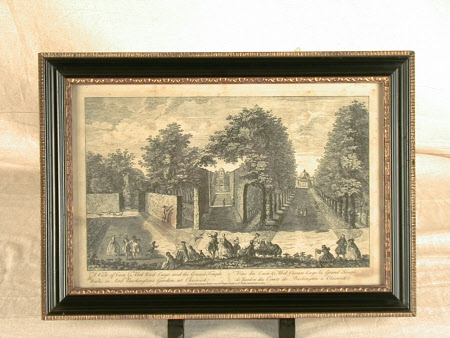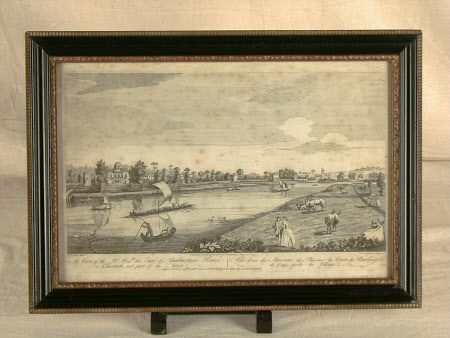A View of the 'Cain and Abel' Bird-Cage, and the Grand Temple Walks, in Lord Burlington's Garden, at Chiswick House
John Fougeron (fl.c.1748 - c.1770)
Category
Art / Prints
Date
Unknown
Materials
Engraving on paper
Measurements
270 x 415 mm
Place of origin
England
Order this imageCollection
Dyrham, Gloucestershire
NT 452641.3
Summary
Print, engraving, A View of the 'Cain and Abel' Bird-Cage, and the Grand Temple Walks, in Lord Burlington's Garden at Chiswick House [Richard Boyle, 3rd Earl of Burlington and 4th Earl of Cork (1694 - 1753)] (after P. Brookes) by John Fougeron (fl.c.1750-1769). One of a set of ten engravings of Chiswick House in Hogarth frames. After Rysbrack; Cain and Abel Birdcage and the grand temple walks, No.30; See also DYR.D.6.a-b and DYR.6.d-j. A view of the alleys (patte d'oie or goose foot) in the gardens at Chiswick House with the Bagnio in the centre and sculpture group on the left.The sculpture of 'Cain and Abel', after the antique as it was called in Lord Burlington's time has resumed to the original name Samson and the Philistine and is now at Chatsworth. The original painting of around 1729-31 (one of a set of eight) by Pieter Andreas Rysbrack (c.1684 - 1748), the elder brother of the better-known sculptor John Michael, without the numerous figures in the foreground, is still at Chiswick House (EH). Pieter Andreas was born in Antwerp and came to England in 1720 and by 1729 had entered Lord Burlington's circle. He was the first in England to undertake such portraits of gardens, which later in the eighteenth and nineteenth centuries gained considerable popularity. It shows the first phase of Lord Burlington's remodelling of the grounds at Chiswick, before William Kent's interventions of the 1730s. Horace Walpole was later to comment of the gardens at Chiswick that their scenery was 'worth more than many fragments of ancient grandeur'. The domed building on the right was built by Gibbs from 1716 and demolished in 1784; the Bagnio in the centre was made to Lord Burlington's designs from 1717 and demolished in 1778.
Provenance
Indigenous collection purchased by Ministry of Works in 1956 and given to Dyrham Park in 1961
Makers and roles
John Fougeron (fl.c.1748 - c.1770), engraver (printmaker) after P. Brookes , artist after Pieter Andreas Rysbrack (Paris c.1684 - London 1748), artist
References
Harris 1979 John Harris, The Artist and the Country House. A History of Country House and Garden View Painting in Britain 1540-1870, London 1979, p. 183, nos. 187a, c, d, f, g Harris 1994 John Harris, The Palladian Revival: Lord Burlington, His Villa and Garden at Chiswick, 1994 Sicca 1982 C. M. Sicca, 'Lord Burlington at Chiswick: Architecture and Landscape', Garden History, 1982, X, no. 1, pp. 55

